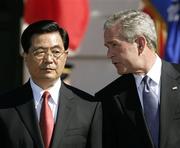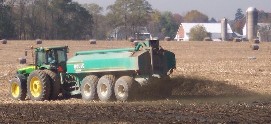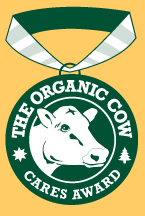 If not, you’d better find out sooner rather than later… otherwise, Uncle Sam may be hauling you off to the federal pen. This week, in a massive raid, federal agents arrested not only 1,100 illegals from a nationwide factory chain, but more importantly, arrested seven current and former managers of the company that employed the illegals. These men are faced with up to 10 years in prision and a $250,000 fine for each alien involved if convicted of the charges.
If not, you’d better find out sooner rather than later… otherwise, Uncle Sam may be hauling you off to the federal pen. This week, in a massive raid, federal agents arrested not only 1,100 illegals from a nationwide factory chain, but more importantly, arrested seven current and former managers of the company that employed the illegals. These men are faced with up to 10 years in prision and a $250,000 fine for each alien involved if convicted of the charges.
In announcing the raid, Homeland Security Secretary Michael Chertoff promised to “come down as hard as possible” on violators of our immigration laws. As for the aliens themselves, most of the 1,187 are being processed for deportation according to DHS officials. Also recently, the Department has had several other successful crackdown operations: nine Baltimore restaurant operators pleaded guilty on a variety of immigration laws; nine managers of two temp agencies in New Jersey, Ohio, and Pennsylvania were charged in a $5.3 million illegal alien scheme; and the Department is working to expand its influence. Congress is pondering appropriations for additional agents to conduct these investigations. There are currently 325 – with additional funding, that number could rise to 525 by year’s end.
Immigration and Customs Enforcement (ICE), a branch of DHS, also unvelied today a comprehensive immigration enforcement strategy for the nation’s interior. The strategy is the second phase of the President’s Secure Borders Initiative, and focuses on three goals, including identifying and removing illegal aliens from the country, enforcing employment laws and worksite compliance, and uprooting the criminal infrastructure smuggling and trafficing illegals into the country. One of the most prominent strategies outlined is punishment of employers who knowingly harbor illegal aliens.
Just for kicks, I Googled “dairy illegal immigrant” – I think you’ll be shocked at the number of stories and sites that reference the number of illegals working on our dairies. Interesting reading, to be sure.
 The Environmental Protection Agency is proposing to exclude agriculture from new air quality standards governing coarse dust particles. The Agency is revising national air quality standards for both coarse and fine dust particles, and the American Farm Bureau Federation is strongly encouraging adoption of the ag exclusion.
The Environmental Protection Agency is proposing to exclude agriculture from new air quality standards governing coarse dust particles. The Agency is revising national air quality standards for both coarse and fine dust particles, and the American Farm Bureau Federation is strongly encouraging adoption of the ag exclusion.
 As we reported
As we reported  USDA
USDA Not that milk production isn’t growing by leaps and bounds both here in the US and, as you’ll recall from a few days ago,
Not that milk production isn’t growing by leaps and bounds both here in the US and, as you’ll recall from a few days ago,  and not the other way around. That’s about to change.
and not the other way around. That’s about to change.  Shooting for a back-to-school campaign launch, Bravo is attempting to earn more of the youth market away from soft-drinks that, parents and educators are concerned, may be causing obesity and dietary issues. Bravo already has a
Shooting for a back-to-school campaign launch, Bravo is attempting to earn more of the youth market away from soft-drinks that, parents and educators are concerned, may be causing obesity and dietary issues. Bravo already has a  Made with 1% milk containing added vitamins, the General Mills line may not be that much healthier than soda. The current flavored milk line, for example, contains upwards of 140-200 calories and as much as 29 grams of sugar per cup. Coca-cola, on the other hand, contains 97 calories and 27 grams of sugar. The vitamins in this case are where the advantage goes to the Bravo product.
Made with 1% milk containing added vitamins, the General Mills line may not be that much healthier than soda. The current flavored milk line, for example, contains upwards of 140-200 calories and as much as 29 grams of sugar per cup. Coca-cola, on the other hand, contains 97 calories and 27 grams of sugar. The vitamins in this case are where the advantage goes to the Bravo product. If not, you’d better find out sooner rather than later… otherwise, Uncle Sam may be hauling you off to the federal pen. This week,
If not, you’d better find out sooner rather than later… otherwise, Uncle Sam may be hauling you off to the federal pen. This week,  The supplements, I mean… not necessary for the kids, that is!
The supplements, I mean… not necessary for the kids, that is!  Japanese dairies have plenty of milk apparently. Milk consumption is in a freefall in the Land of the Rising Sun, while production has skyrocketed. With limited success in marketing efforts to increase consumption, the Japanese government is working to dispense excess milk as foreign aid.
Japanese dairies have plenty of milk apparently. Milk consumption is in a freefall in the Land of the Rising Sun, while production has skyrocketed. With limited success in marketing efforts to increase consumption, the Japanese government is working to dispense excess milk as foreign aid. A Vermont businessman has engineered a
A Vermont businessman has engineered a  The Organic Cow
The Organic Cow